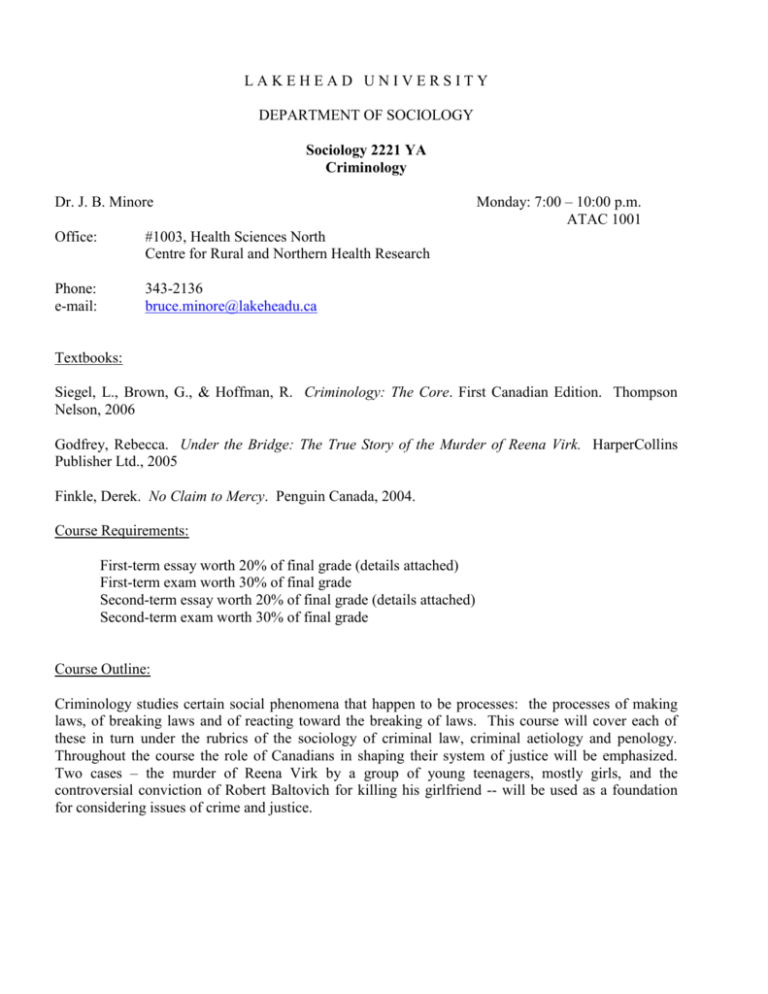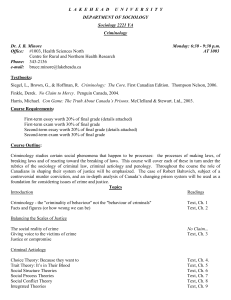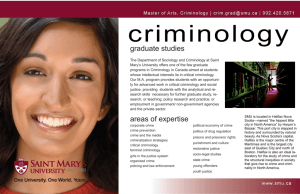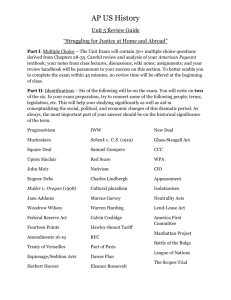Sociology 2221 YA - Lakehead University
advertisement

LAKEHEAD UNIVERSITY DEPARTMENT OF SOCIOLOGY Sociology 2221 YA Criminology Dr. J. B. Minore Office: #1003, Health Sciences North Centre for Rural and Northern Health Research Phone: e-mail: 343-2136 bruce.minore@lakeheadu.ca Monday: 7:00 – 10:00 p.m. ATAC 1001 Textbooks: Siegel, L., Brown, G., & Hoffman, R. Criminology: The Core. First Canadian Edition. Thompson Nelson, 2006 Godfrey, Rebecca. Under the Bridge: The True Story of the Murder of Reena Virk. HarperCollins Publisher Ltd., 2005 Finkle, Derek. No Claim to Mercy. Penguin Canada, 2004. Course Requirements: First-term essay worth 20% of final grade (details attached) First-term exam worth 30% of final grade Second-term essay worth 20% of final grade (details attached) Second-term exam worth 30% of final grade Course Outline: Criminology studies certain social phenomena that happen to be processes: the processes of making laws, of breaking laws and of reacting toward the breaking of laws. This course will cover each of these in turn under the rubrics of the sociology of criminal law, criminal aetiology and penology. Throughout the course the role of Canadians in shaping their system of justice will be emphasized. Two cases – the murder of Reena Virk by a group of young teenagers, mostly girls, and the controversial conviction of Robert Baltovich for killing his girlfriend -- will be used as a foundation for considering issues of crime and justice. 2 Topics Introduction Readings Criminology - the "criminality of behaviour" not the "behaviour of criminals" Facts and figures (or how wrong we can be) Text, Ch. 1 Text, Ch. 2 Balancing the Scales of Justice The social reality of crime Giving voice to the victims of crime Justice or compromise Under the . . . Text, Ch. 3 Criminal Aetiology Choice Theory: Because they want to Trait Theory: It’s in Their Blood Social Structure Theories Social Process Theories Social Conflict Theory Integrated Theories Text, Ch. 4. Text, Ch. 5 Text, Ch. 6 Text, Ch. 7 Text, Ch. 8 Text, Ch. 9 Penology (the treatment of the criminal in Canadian society) Decision makers - the police (lectures) Violent Crime (reading) Decision makers - the courts (lectures) Property Crimes (reading) Detention - lectures & reading White-Collar and Organized Crime (reading) In the community Probation and parole (lectures) Public Order Crimes The system in perspective Continuity and change (lectures) Text, Ch.10 Text, Ch.11 No Claim . . . Text, Ch. 12 Text, Ch. 13 3 First-Term Essay (worth 20 marks) All students will submit a brief essay (not to exceed six printed pages, double spaced, 12 point font) on the following two-part question. Papers must be submitted by Monday, October 16, 2006. (i) The death of a young girl at the hands of her peers, recounted in Under the Bridge: The True Story of the Murder of Reena Virk, gave rise to widespread concern about increasing involvement of young girls in crime. Explain why this crime precipitated a “moral panic.” In light of the evidence about female participation in violent youth crime, was the reaction justified? Did the public’s reaction affect the way in which the matter was dealt with by the courts? (ii) Do the girls involved in the Virk case fit the profile of female young offenders outlined in Corrado, R., Odgers, C., and Cohen, I., “The Incarceration of Female Young Offenders: Protection for Whom.” Canadian Journal of Criminology 42 (April 2000): 189-207? Critically apply Gottfredson and Hirschi’s general theory of crime (text book, pp 199-203) to explain the behaviour of the young people involved in the Virk case. Second-Term Essay (worth 20 marks) All students will submit a brief essay (not to exceed six printed pages, double spaced, 12 point font) on the following two-part question. Papers must be submitted by Monday, February 12, 2006. (i) Critics have argued that the prosecution of Robert Baltovich occurred because of the authorities "tunnel vision" -- their unwillingness to consider or pursue information which did not fit with their theory that Mr. Baltovich was responsible for the murder of his girlfriend, Elizabeth Bain. In No Claim to Mercy, Derek Finkle details many instances of such fixed thinking. Give ONE example in detail from either the police investigation or the Crown's prosecution of the case. Explain why the example you have chosen could have contributed to Mr. Baltovich’s conviction. And explain why the authorities directly involved in the decisions relating to this matter would chose to ignore or discount contradictory evidence. (ii) In July, 2005, Robert Baltovich was ordered to stand trial for a second time. At an appeal hearing the court heard evidence (much of it related to Paul Bernardo) which his lawyers claimed made it “highly arguable” that a miscarriage of justice occurred and, also, about “several omissions and errors” made by Judge John O’Driscoll at the original trial that they felt twisted the interpretation of evidence to favour the prosecution. Cite ONE example of judicial intervention and explain how it could have affected the outcome of the jury’s decision at the original trial. Can we ensure that a jury-based criminal justice system will not make errors and convict innocent people? If you answer "yes", explain why? If you answer "no", explain why not? 4







